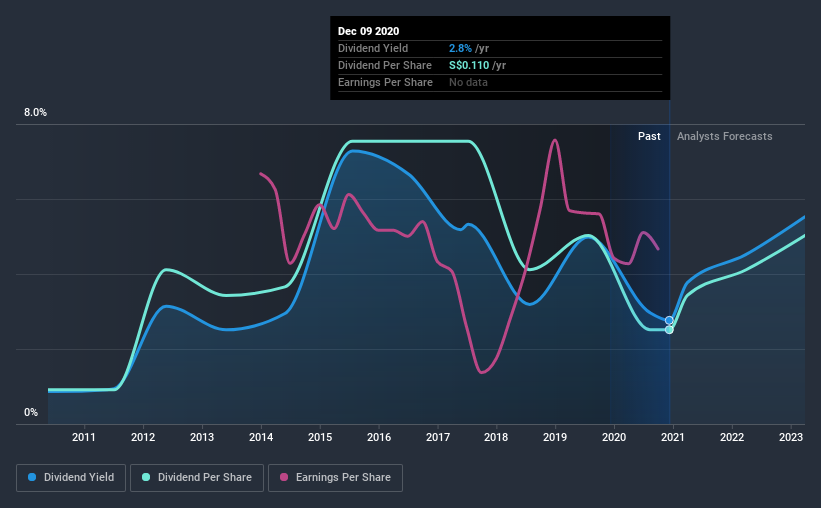- Singapore
- /
- Real Estate
- /
- SGX:B61
Would Bukit Sembawang Estates Limited (SGX:B61) Be Valuable To Income Investors?

Is Bukit Sembawang Estates Limited (SGX:B61) a good dividend stock? How can we tell? Dividend paying companies with growing earnings can be highly rewarding in the long term. If you are hoping to live on your dividends, it's important to be more stringent with your investments than the average punter. Regular readers know we like to apply the same approach to each dividend stock, and we hope you'll find our analysis useful.
A 2.8% yield is nothing to get excited about, but investors probably think the long payment history suggests Bukit Sembawang Estates has some staying power. Some simple research can reduce the risk of buying Bukit Sembawang Estates for its dividend - read on to learn more.
Click the interactive chart for our full dividend analysis

Payout ratios
Companies (usually) pay dividends out of their earnings. If a company is paying more than it earns, the dividend might have to be cut. Comparing dividend payments to a company's net profit after tax is a simple way of reality-checking whether a dividend is sustainable. In the last year, Bukit Sembawang Estates paid out 12% of its profit as dividends. With a low payout ratio, it looks like the dividend is comprehensively covered by earnings.
We also measure dividends paid against a company's levered free cash flow, to see if enough cash was generated to cover the dividend. Bukit Sembawang Estates paid out 3.1% of its free cash flow as dividends last year, which is conservative and suggests the dividend is sustainable. It's positive to see that Bukit Sembawang Estates' dividend is covered by both profits and cash flow, since this is generally a sign that the dividend is sustainable, and a lower payout ratio usually suggests a greater margin of safety before the dividend gets cut.
With a strong net cash balance, Bukit Sembawang Estates investors may not have much to worry about in the near term from a dividend perspective.
Consider getting our latest analysis on Bukit Sembawang Estates' financial position here.
Dividend Volatility
One of the major risks of relying on dividend income, is the potential for a company to struggle financially and cut its dividend. Not only is your income cut, but the value of your investment declines as well - nasty. For the purpose of this article, we only scrutinise the last decade of Bukit Sembawang Estates' dividend payments. The dividend has been cut on at least one occasion historically. During the past 10-year period, the first annual payment was S$0.04 in 2010, compared to S$0.1 last year. This works out to be a compound annual growth rate (CAGR) of approximately 11% a year over that time. Bukit Sembawang Estates' dividend payments have fluctuated, so it hasn't grown 11% every year, but the CAGR is a useful rule of thumb for approximating the historical growth.
It's not great to see that the payment has been cut in the past. We're generally more wary of companies that have cut their dividend before, as they tend to perform worse in an economic downturn.
Dividend Growth Potential
Given that the dividend has been cut in the past, we need to check if earnings are growing and if that might lead to stronger dividends in the future. In the last five years, Bukit Sembawang Estates' earnings per share have shrunk at approximately 2.2% per annum. A modest decline in earnings per share is not great to see, but it doesn't automatically make a dividend unsustainable. Still, we'd vastly prefer to see EPS growth when researching dividend stocks.
Conclusion
To summarise, shareholders should always check that Bukit Sembawang Estates' dividends are affordable, that its dividend payments are relatively stable, and that it has decent prospects for growing its earnings and dividend. First, we like that the company's dividend payments appear well covered, although the retained capital also needs to be effectively reinvested. Earnings per share have been falling, and the company has cut its dividend at least once in the past. From a dividend perspective, this is a cause for concern. While we're not hugely bearish on it, overall we think there are potentially better dividend stocks than Bukit Sembawang Estates out there.
Market movements attest to how highly valued a consistent dividend policy is compared to one which is more unpredictable. Still, investors need to consider a host of other factors, apart from dividend payments, when analysing a company. For instance, we've picked out 2 warning signs for Bukit Sembawang Estates that investors should take into consideration.
If you are a dividend investor, you might also want to look at our curated list of dividend stocks yielding above 3%.
If you decide to trade Bukit Sembawang Estates, use the lowest-cost* platform that is rated #1 Overall by Barron’s, Interactive Brokers. Trade stocks, options, futures, forex, bonds and funds on 135 markets, all from a single integrated account. Promoted
Valuation is complex, but we're here to simplify it.
Discover if Bukit Sembawang Estates might be undervalued or overvalued with our detailed analysis, featuring fair value estimates, potential risks, dividends, insider trades, and its financial condition.
Access Free AnalysisThis article by Simply Wall St is general in nature. It does not constitute a recommendation to buy or sell any stock, and does not take account of your objectives, or your financial situation. We aim to bring you long-term focused analysis driven by fundamental data. Note that our analysis may not factor in the latest price-sensitive company announcements or qualitative material. Simply Wall St has no position in any stocks mentioned.
*Interactive Brokers Rated Lowest Cost Broker by StockBrokers.com Annual Online Review 2020
Have feedback on this article? Concerned about the content? Get in touch with us directly. Alternatively, email editorial-team@simplywallst.com.
About SGX:B61
Bukit Sembawang Estates
An investment holding company, engages in the property development, investments, and related activities in Singapore.
Flawless balance sheet and good value.
Market Insights
Community Narratives


